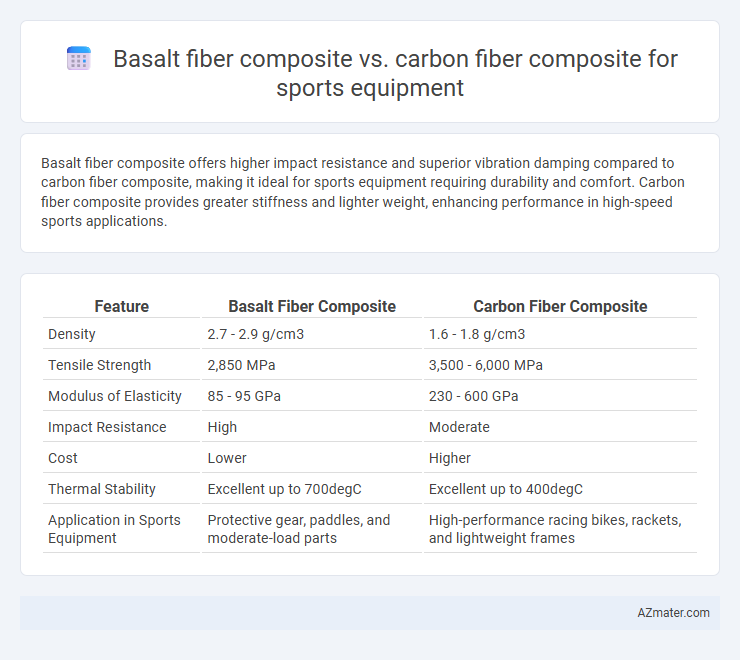Basalt fiber composite offers higher impact resistance and superior vibration damping compared to carbon fiber composite, making it ideal for sports equipment requiring durability and comfort. Carbon fiber composite provides greater stiffness and lighter weight, enhancing performance in high-speed sports applications.
Table of Comparison
| Feature | Basalt Fiber Composite | Carbon Fiber Composite |
|---|---|---|
| Density | 2.7 - 2.9 g/cm3 | 1.6 - 1.8 g/cm3 |
| Tensile Strength | 2,850 MPa | 3,500 - 6,000 MPa |
| Modulus of Elasticity | 85 - 95 GPa | 230 - 600 GPa |
| Impact Resistance | High | Moderate |
| Cost | Lower | Higher |
| Thermal Stability | Excellent up to 700degC | Excellent up to 400degC |
| Application in Sports Equipment | Protective gear, paddles, and moderate-load parts | High-performance racing bikes, rackets, and lightweight frames |
Introduction to Fiber Composites in Sports Equipment
Fiber composites, including basalt fiber and carbon fiber composites, are revolutionizing sports equipment by offering enhanced strength-to-weight ratios and improved durability. Basalt fiber composites excel in impact resistance and cost-efficiency, making them ideal for protective gear and moderate-performance applications. Carbon fiber composites dominate high-performance sports equipment with superior stiffness, lightweight properties, and precision engineering, driving advancements in bicycles, tennis rackets, and racing gear.
Composition and Manufacturing of Basalt Fiber Composites
Basalt fiber composites consist of fibers derived from volcanic basalt rock, offering a natural, eco-friendly alternative with high thermal resistance and excellent vibration damping properties. The manufacturing process involves melting basalt rock at approximately 1500degC, followed by fiberizing through controlled extrusion and cooling to produce continuous basalt fibers, which are then impregnated with resin matrices such as epoxy or polyester for composite fabrication. Compared to carbon fiber composites, basalt fibers provide competitive mechanical strength and enhanced impact resistance, making them increasingly popular in sports equipment like racquets and protective gear.
Composition and Manufacturing of Carbon Fiber Composites
Carbon fiber composites consist of carbon fibers embedded in a polymer matrix, typically epoxy resin, offering high tensile strength and low weight for sports equipment like tennis rackets and bicycles. The manufacturing process involves layering unidirectional carbon fiber sheets, impregnating them with resin, and curing under heat and pressure, which ensures excellent structural integrity and stiffness. In contrast, basalt fiber composites use fibers derived from volcanic rock, providing enhanced impact resistance and environmental sustainability but generally lower stiffness compared to carbon fiber composites.
Mechanical Properties Comparison: Strength, Stiffness, and Flexibility
Basalt fiber composites exhibit high tensile strength and superior impact resistance, making them ideal for sports equipment requiring durability and shock absorption. Carbon fiber composites offer exceptional stiffness and higher strength-to-weight ratios, enhancing performance in applications where rigidity and lightweight properties are critical. Basalt fibers provide greater flexibility compared to carbon fibers, allowing sports gear to better withstand dynamic stresses without compromising resilience.
Weight and Performance Impact in Sports Applications
Basalt fiber composites offer a lightweight alternative to carbon fiber composites, with slightly higher density but superior impact resistance, making them ideal for sports equipment that requires durability and shock absorption. Carbon fiber composites provide exceptional stiffness and strength-to-weight ratio, significantly enhancing performance and responsiveness in high-performance sports gear such as racing bicycles and tennis rackets. The choice between basalt and carbon fiber hinges on the specific weight sensitivity and performance demands of the sports application.
Durability and Environmental Resistance
Basalt fiber composites exhibit superior impact resistance and enhanced durability under harsh environmental conditions compared to carbon fiber composites, making them highly suitable for sports equipment subjected to frequent physical stress. These composites demonstrate excellent resistance to moisture, UV radiation, and chemical corrosion, outperforming carbon fiber in maintaining structural integrity over time. Carbon fiber composites offer high stiffness and strength but are more susceptible to environmental degradation, which can compromise longevity in outdoor sports applications.
Cost Analysis: Basalt vs Carbon Fiber Composites
Basalt fiber composites offer a cost advantage over carbon fiber composites, with raw materials typically priced 20-40% lower, making them a budget-friendly option for sports equipment manufacturers. Production costs for basalt fibers are also reduced due to simpler manufacturing processes and lower energy requirements compared to carbon fiber production. Despite slightly lower tensile strength, basalt fiber composites provide sufficient durability for many sports applications while significantly cutting overall expenses.
Sustainability and Environmental Impact
Basalt fiber composites offer a more sustainable alternative to carbon fiber composites due to their natural origin and lower energy consumption during production, resulting in reduced carbon footprint. Basalt fibers are derived from volcanic rock, making them abundant and non-toxic, whereas carbon fiber production relies on energy-intensive processes and fossil fuels. Using basalt fiber composites in sports equipment enhances recyclability and biodegradability, contributing to eco-friendly product life cycles and minimizing environmental impact.
Common Sports Equipment Applications
Basalt fiber composites are increasingly used in sports equipment such as hockey sticks, surfboards, and protective helmets due to their high impact resistance and cost-effectiveness. Carbon fiber composites dominate applications requiring superior strength-to-weight ratio and stiffness, including bicycle frames, tennis rackets, and racing car components. Both materials enhance performance and durability, with basalt offering better vibration damping and carbon fiber providing unmatched lightweight rigidity.
Choosing the Right Composite for Sports Equipment
Basalt fiber composite offers superior vibration damping and impact resistance, making it ideal for sports equipment requiring durability and shock absorption, such as hockey sticks and tennis rackets. Carbon fiber composite provides exceptional stiffness and lightweight properties, enhancing performance in high-speed sports like cycling and racing. Selecting the right composite depends on balancing factors like strength-to-weight ratio, flexibility, and cost to optimize athletic performance and equipment longevity.

Infographic: Basalt fiber composite vs Carbon fiber composite for Sports equipment
 azmater.com
azmater.com